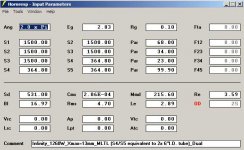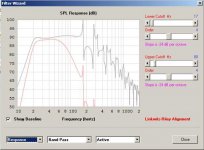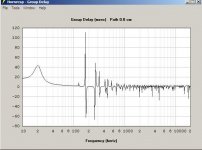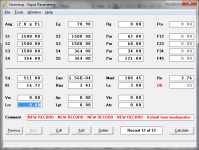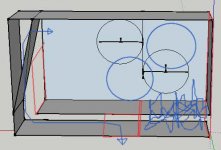Isobaric does sound tighter (especially with cheap drivers) and can be tuned lower due to airmass moving along between the drivers. Smaller box too.
I cannot disagree on that. I am merely implying that there is no free lunch.
I just wanted to give an alternative to the wasteful 4x12" approach, if the sd of a 18" is needed then that it what you should use. Those 18"s are so cheap, and they have an fs of 25hz, the VAS is 280L though, but put them in isobaric instead. The OP will probably get his design at the goal of 100L.
Edit: Silly me...
Last edited:
It depends how small the box needs to be for one driver. I don't think there would be any point in using, say, two Peerless XLS10s as a compound driver. The box would still be quite small if both were looking at the outside world and you'd get the potential benefits of reaction force cancellation if they were on opposite sides of a box, along with more swept area. For a sealed alignment you'd be doing well if the compound version wasn't bigger. It depends on the driver parameters, so compound loading, like other techniques needs to be assessed on a case-by-case basis.
I like those 18"ers.
When I come to build something really big, they'll be on the list.
For now, I'm quite content with this JBL in its sealed box. The bigger box will be a long-term goal, as all the tools are currently 80 miles away.
I think, once I have my own place, one of these JBLs per side, crossed to a 6" two-way standmount design, would be impressive.
Somewhere between a 3-way and a 2.2 system. Crossover at say 120Hz.
That'd be looking quite far into the future, though - I've only just started my degree.
Still, its nice to dream occasionally.
Chris
When I come to build something really big, they'll be on the list.
For now, I'm quite content with this JBL in its sealed box. The bigger box will be a long-term goal, as all the tools are currently 80 miles away.
I think, once I have my own place, one of these JBLs per side, crossed to a 6" two-way standmount design, would be impressive.
Somewhere between a 3-way and a 2.2 system. Crossover at say 120Hz.
That'd be looking quite far into the future, though - I've only just started my degree.
Still, its nice to dream occasionally.
Chris
http://www.diyaudio.com/forums/subwoofers/221660-new-ht-subwoofer-dayton-ref-18-a.html
Not sure if you've seen it, but 20hz extension is my main concern with this project with limited space.
It's about $400 all said and done for driver, terminal, Baltic birch, glue, stain etc.
that of course doesn't include amp power or processing, but for the sub itself I'm betting it'll be hard to beat the quality and output for $400 from a 225L box....
Not sure if you've seen it, but 20hz extension is my main concern with this project with limited space.
It's about $400 all said and done for driver, terminal, Baltic birch, glue, stain etc.
that of course doesn't include amp power or processing, but for the sub itself I'm betting it'll be hard to beat the quality and output for $400 from a 225L box....
Hi guys,
Bumping an old thread.
Here's the updated situation: I have a Samson Servo-550 that'll do half a kilowatt (total) into 8ohm (bridged) or 4ohm/ch.
I also bought myself a second driver, which was installed in the same cabinet as the first, by cutting a hole in the back. 5mm T-nuts weren't available, so I wasn't able to do isobaric loading as I would've liked.
Not even close to optimal, but it got me some more output and force cancellation.
I'm now running a pair of Behringer B2031P speakers, and using the active XO to high pass them around 60Hz. The sub is low passed there, and a 31-band graphic is used to form a crude Linkwitz Transform, giving a response flat to a rather low frequency.
Though now here's a new problem: I moved the system into the lounge-kitchen area and put a Dredd (film) on. There's a particular scene with some very strong constant <20Hz content, and the amplifier clipped. Continuously.
Tiny box, low bass, so efficiency is suffering massively.
Now, however, I have the option to build something bigger. I'm moving into a shared house and could do with some kind of bench to put my sound equipment on, a couple of feet tall, mayble a foot deep and, say, 5 feet wide. Probably more cabinet volume than needed, so I'd happily build it a little smaller
I've been playing with Hornresp again and found that offset driver systems result in a large (~500ms, not a typo) group delay spike around 60Hz once they're tuned around 20Hz. I'd expect that to be clearly audible, so am thinking that such a design isn't a fantastic choice here.
A large ported box for both drivers looks fairly promising. By combining the air volume for the pair of them I don't need to worry so much about tiny ports chuffing - bigger air volume means shorter ports for a given tuning.
Gotta get back to moving, but I'll post some ideas I have in the next few days.
Chris
Bumping an old thread.
Here's the updated situation: I have a Samson Servo-550 that'll do half a kilowatt (total) into 8ohm (bridged) or 4ohm/ch.
I also bought myself a second driver, which was installed in the same cabinet as the first, by cutting a hole in the back. 5mm T-nuts weren't available, so I wasn't able to do isobaric loading as I would've liked.
Not even close to optimal, but it got me some more output and force cancellation.
I'm now running a pair of Behringer B2031P speakers, and using the active XO to high pass them around 60Hz. The sub is low passed there, and a 31-band graphic is used to form a crude Linkwitz Transform, giving a response flat to a rather low frequency.
Though now here's a new problem: I moved the system into the lounge-kitchen area and put a Dredd (film) on. There's a particular scene with some very strong constant <20Hz content, and the amplifier clipped. Continuously.
Tiny box, low bass, so efficiency is suffering massively.
Now, however, I have the option to build something bigger. I'm moving into a shared house and could do with some kind of bench to put my sound equipment on, a couple of feet tall, mayble a foot deep and, say, 5 feet wide. Probably more cabinet volume than needed, so I'd happily build it a little smaller
I've been playing with Hornresp again and found that offset driver systems result in a large (~500ms, not a typo) group delay spike around 60Hz once they're tuned around 20Hz. I'd expect that to be clearly audible, so am thinking that such a design isn't a fantastic choice here.
A large ported box for both drivers looks fairly promising. By combining the air volume for the pair of them I don't need to worry so much about tiny ports chuffing - bigger air volume means shorter ports for a given tuning.
Gotta get back to moving, but I'll post some ideas I have in the next few days.
Chris
Thanks Oliver, that looks like exactly the thing I'm after.
I've been playing around with tuning that design slightly lower, so that I can run the port along the bottom of the cabinet with a side exit, using the width of a 4x8 sheet as the width of the cabinet.
When time allows I'll fire up Google Sketch-up and see if I can make something of this.
Chris
I've been playing around with tuning that design slightly lower, so that I can run the port along the bottom of the cabinet with a side exit, using the width of a 4x8 sheet as the width of the cabinet.
When time allows I'll fire up Google Sketch-up and see if I can make something of this.
Chris
Hi chris661,
Here are two threads using this general concept:
- http://www.diyaudio.com/forums/subw...ded-transmission-line-od-ml-tl-design-bj.html
- http://www.diyaudio.com/forums/subwoofers/223358-lab-15-design-suggestions-ht-use.html
There are a few drawings in those threads that may help. Maybe bjorno will chime in with some idea for your form factor (I'm guessing about 4'W x 2'H x 1'D ? 5'W would be better). I'm looking forward to seeing what you come up with for this dual driver enclosure.
Regards,
Here are two threads using this general concept:
- http://www.diyaudio.com/forums/subw...ded-transmission-line-od-ml-tl-design-bj.html
- http://www.diyaudio.com/forums/subwoofers/223358-lab-15-design-suggestions-ht-use.html
There are a few drawings in those threads that may help. Maybe bjorno will chime in with some idea for your form factor (I'm guessing about 4'W x 2'H x 1'D ? 5'W would be better). I'm looking forward to seeing what you come up with for this dual driver enclosure.
Regards,
Hi Oliver, attached is a .zip folder that has my sketch-up model inside.
I kept the cross-sectional areas the same, but changed the lengths around a little. I found the alignment was very lenient of the ratio of L12/L23, so, while I made some attempt to keep the drivers equidistant from the port, I didn't put that much effort in.
I'm also using slightly different T/S parameters to you. Presumably you're using a different driver.
Either way, I get a gentle slope down from 90Hz to around 30Hz, and the response rises slightly below that before falling off rapidly. Given comments earlier about low Q sealed boxes, I figured such a response wouldn't be undesirable, with the slight knee providing a "powerful" sound. If I don't like it, I can eq it out. But hey, free headroom.
The port length was changed so that I could use the width of a standard 4x8 sheet as the width of the cabinet. I haven't checked yet, but I suspect this'll go on to one sheet of wood, so I might splash out and get something half-decent.
I'm planning on having the port firing out of the right-hand side, as the entrance to the room is that way and I'd like to add some bright colours.
There's no internet at my new place (yet), so I'm having to travel to the university library to post things.
Chris
I kept the cross-sectional areas the same, but changed the lengths around a little. I found the alignment was very lenient of the ratio of L12/L23, so, while I made some attempt to keep the drivers equidistant from the port, I didn't put that much effort in.
I'm also using slightly different T/S parameters to you. Presumably you're using a different driver.
Either way, I get a gentle slope down from 90Hz to around 30Hz, and the response rises slightly below that before falling off rapidly. Given comments earlier about low Q sealed boxes, I figured such a response wouldn't be undesirable, with the slight knee providing a "powerful" sound. If I don't like it, I can eq it out. But hey, free headroom.
The port length was changed so that I could use the width of a standard 4x8 sheet as the width of the cabinet. I haven't checked yet, but I suspect this'll go on to one sheet of wood, so I might splash out and get something half-decent.
I'm planning on having the port firing out of the right-hand side, as the entrance to the room is that way and I'd like to add some bright colours.
There's no internet at my new place (yet), so I'm having to travel to the university library to post things.
Chris
Attachments
Post #49
Hi Chris,
That basically looks good to me, and very straight forward. You may want to play around a little with L34=.01 (or so), and the modified layout suggestion in the attachment; I have not put any numbers to the fold, or the (free-hand) filling.
Regards,
Hi Chris,
That basically looks good to me, and very straight forward. You may want to play around a little with L34=.01 (or so), and the modified layout suggestion in the attachment; I have not put any numbers to the fold, or the (free-hand) filling.
Regards,
Attachments
Hi Oliver,
The port will be running along the floor, so I figure a side or front exit is required.
Taking a hint from your suggested layout, I could achieve a front exit by adding a shorter board and keeping the diagonal one. I'll draw this up and see what can be done.
I suspect this alignment is almost acting as a standard bass-reflex, as altering L34 alters the tuning and response shape as reducing the volume of a ported box would.
Rather excited about putting saw to wood some time soon, though of course there's still a bit of work to be done before that happens...
Chris
The port will be running along the floor, so I figure a side or front exit is required.
Taking a hint from your suggested layout, I could achieve a front exit by adding a shorter board and keeping the diagonal one. I'll draw this up and see what can be done.
I suspect this alignment is almost acting as a standard bass-reflex, as altering L34 alters the tuning and response shape as reducing the volume of a ported box would.
Rather excited about putting saw to wood some time soon, though of course there's still a bit of work to be done before that happens...
Chris
Hi chris661,
Post #51: "...this alignment is almost acting as a standard bass-reflex,..."
Yes, that's what it looks like, but Martin J. King who did the basic work on the mass loaded transmission line is adamant about the fact that it is a transmission line. It also benefits (needs?) from some stuffing (filling) along the L12 path. Here is a link to his web site: Quarter Wavelength Loudspeaker Design ; and, bjorno has been very helpful in determining the amount and location of stuffing necessary, etc.. For indoor use you may want a lightly slanted response (lower at the bottom end), but in the Hornresp simulation a little hump at the bottom cannot do any harm, as it will be atttenuated by the stuffing, and by the necessary HP filter.
Regards,
Post #51: "...this alignment is almost acting as a standard bass-reflex,..."
Yes, that's what it looks like, but Martin J. King who did the basic work on the mass loaded transmission line is adamant about the fact that it is a transmission line. It also benefits (needs?) from some stuffing (filling) along the L12 path. Here is a link to his web site: Quarter Wavelength Loudspeaker Design ; and, bjorno has been very helpful in determining the amount and location of stuffing necessary, etc.. For indoor use you may want a lightly slanted response (lower at the bottom end), but in the Hornresp simulation a little hump at the bottom cannot do any harm, as it will be atttenuated by the stuffing, and by the necessary HP filter.
Regards,
Last edited:
#1 What music do you have that reaches 20? 25 to 30 is fine unless you listen to heavy organ or distorted special effects.
How about piano. This beauty here can take an F0 (21.83Hz):
Model 290 Imperial
Of course no one has managed to properly record it either. You just have to go meet it in person. Awesome. And humbling.
Quick update and bump:
I'll be getting some wood cut up some time soon. I'll be using 18mm MDF and doubling up the front baffle so that I can rebate the drivers and strengthen the big panels. There will, of course, be plenty of bracing.
I've also decided to keep the port side-firing.
Finish will be spray paints, similar to DrDyna's recent build.
Chris
I'll be getting some wood cut up some time soon. I'll be using 18mm MDF and doubling up the front baffle so that I can rebate the drivers and strengthen the big panels. There will, of course, be plenty of bracing.
I've also decided to keep the port side-firing.
Finish will be spray paints, similar to DrDyna's recent build.
Chris
- Status
- This old topic is closed. If you want to reopen this topic, contact a moderator using the "Report Post" button.
- Home
- Loudspeakers
- Subwoofers
- Hitting 20Hz cheaply...
